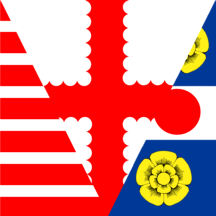 by Arnaud Leroy
by Arnaud Leroy
Last modified: 2005-04-02 by ivan sache
Keywords: haute-marne | colombey-les-deux-eglises | de gaulle (charles) |
Links: FOTW homepage |
search |
disclaimer and copyright |
write us |
mirrors
See also:
The small village of Colombey-les-Deux-Eglises, located in the borders of Champagne, Lorraine and Burgundy, was in the past a stopping place on the road Paris-Basle. The destiny of Colombey changed in 1933 when Charles de Gaulle bought there the estate of La Boisserie, where he retired when he abandoned the power in 1946 and then 1969, and eventually died. Colombey is today a place of pilgrimage, especially since a huge cross of Lorraine was built on the "Mountain" dominating the village.
De Gaulle bought the estate La Boisseriee, a former brewery
(brasserie) in May 1934. He selected Colombey because the village was
located half-distance between Paris and Germany, where he was then
posted most the time.
The house was severely damaged during the Second World War: the roof
burned down and a wall crashed down.
De Gaulle resigned from the Presidency of the Republic on 20 January
1946; on 30 May, he and his family could come back to the house, to
which an angle tower and a porch over the entrance gate had been added.
The house was not significantly modified since then. The period from
1946 to 1958 is known as la traversée du désert (the crossing of the
desert). De Gaulle mostly stayed in Colombey, where he wrote his Mémoires de Guerre
and prepared his return to the power. In the municipal
election of 1947, de Gaulle, although not candidate, was elected, but
he refused the mandate.
In 1958, de Gaulle invited in Colombey the German Chancellor Konrad
Adenauer, and this visit was the first step of the Franco-German
reconciliation. Adenauer was the only foreign head of state invited in
La Boisserie.
In 1960, the cyclist Tour de France stopped in Colombey. The race director, Jacques Goddet, was told that de Gaulle was staying in
Colombey, crossed by the Tour during the 20th stage Besançon-Troyes.
The whole pack stopped for two minutes. De Gaulle first greeted the
Champion of France Henri Anglade, then the leader of the race, Gastone
Nencini, telling him: Bravo ! Maintenant vous avez gagné ! Paris n'est
plus loin ! (Congratulations! Now you've won! Paris is not far!). De
Gaulle also caught the ball in the presidential stand during a final of
the football French Cup.
On 27 April 1969, de Gaulle resigned a second time from the Presidency
after the negative answer to a referendum, and retired in Colombey.
On 9 November 1970 around 19:00, de Gaulle sat down in order to play
patience; he was hit by an aortic aneuvrismal rupture and died
immediatly.
In his will, written in 1952, de Gaulle refused any public hommage to
his body, except from his brother-in-arms members of the Liberation
Order and from the people of Colombey. He was buried in the village
cemetary of Colombey. In parallel, an official ceremony involving 80
heads of state took place in the Notre-Dame cathedral in Paris.
The village of Colombey is dominated by a small hill (397 m), locally
called Montagne. On 18 June 1972, the Memorial made of a huge cross
of Lorraine was inaugurated on the Mountain.
In 1954, de Gaulle said to a journalist: "Look at that hill. It is the
highest here. After my death, they will build there a Cross of
Lorraine". According to André Malraux, de Gaulle added: "Nobody will
come, except rabbits involved in resistance actions".
On 23 March 1971, a National Committee, acknwledged by de Gaulle's
family, was set up, presided by Henri Duvillard, Minister of the War
Veterans and patroned by President of the Republic Georges Pompidou.
The Committee selected the highest place of Colombey as the place for
the Memorial. Several millions of French people and donators from 77
foreign countries contributed to the funding of the project. Lebanon
offered 1,000 ceders planted on the hill during a separate ceremony. A
piece of land of 30 ha was purchased and the Memorial was selected
among 12 proposals on 3 November 1971. The selected proposal was made
public on 7 January 1972. The building site started on 25 January and
the Memorial was inaugurated on 18 June.
The designers of the Memorial are the architects Marc Nebinger and
Michel Mosser. The cross weights 1,500 tons and is 43.50 m high. It is
made of Breton pink granit blocks and bronze shields.
A museum should be build in 2006 near the Memorial.
Ivan Sache, 9 November 2004
There is no municipal flag flying in Colombey (information received by Pascal Vagnat from the municipal administration), but there is a flag of
Colombey flying in the Swiss municipality of Assens (Vaud), which is
twinned with Colombey since 2002. Nicolas Deprez photographied in
August 2004 a square banner of the arms of Colombey hoisted on the
balcony of the city hall of Assens.
Unfortunately, there are no information available on the
origin and meaning of the arms of Colombey.
Ivan Sache, 9 November 2004